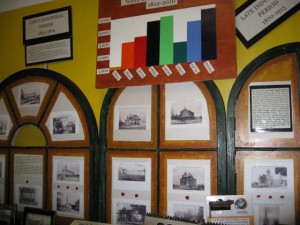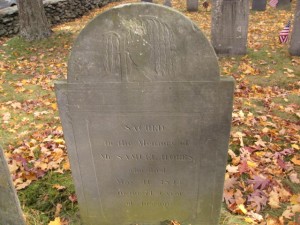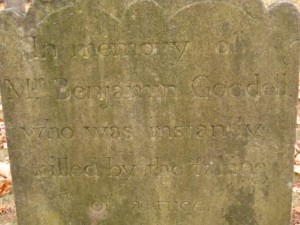The last major event celebrating our town’s 200th birthday was held this morning at the North Brookfield Elementary School, and I was glad I took the time to attend. I’ve been walking along Ward Street near my house since I moved here twenty years ago, but of course I had no inkling as to why there was a street with such a name. Today I found out: Oliver Ward, whose home and factory were located on this street, was the driving force behind our town’s rise to manufacturing prominence in the early years of the nineteenth century.
North Brookfield residents James Buzzell and Linda Grace spent months researching the life and times of this industry pioneer. Their efforts, and contributions from dozens of others, culminated in a special Historical Society exhibit, a 14-page brochure, and the talk in the Elementary School Auditorium. There was a large turn-out for this event, which I’m sure was gratifying to the two researchers and all who put so much effort into this fascinating project.
North Brookfield’s town seal includes the figure of a shoemaker, testifying to the importance of shoe making in the town’s history. And who can dispute the importance of shoes to human beings? Some stats I found on the web suggest that “the global footwear market is expected to reach $195 billion by 2015 . . . with volume sales exceeding 13 billion pairs by 2012.” Although our town is no longer a shoe manufacturing powerhouse, our largest private employer is the Quabaug Rubber Company, one of whose products is Vibram soles. Vibram is an Italian company named for its founder, Vitale Bramani, a mountaineer credited with inventing this type of rubber sole. Today, the Vibram sole is used extensively in heavy-duty work boots, including boots for the US military. I myself own a pair of Merrell hiking boots with Vibram soles — they’re great.
In the late 1700s, North Brookfield, not surprisingly, was largely agricultural, with grain and hay as the main commercial crops; livestock and dairy products were also traded locally. There were a few lumber and grist mills, and a fulling mill for processing woolen cloth. So, how did we become known as “Shoe Town”? It seemed an unlikely transition, with an unlikely man, Oliver Ward, as the catalyst. He was born in Grafton in 1753 and orphaned at age nine. Fortunately, Oliver and his younger siblings were taken in by his uncle, Mark Batcheller of Sutton. Oliver grew up in Sutton, close to his cousins Ezra and Tyler Batcheller, and then learned the tanning trade in Grafton. Married in February 1809 to Elizabeth Phillips of Grafton, Oliver purchased a property in North Brookfield in April of that year. In May, his son Joseph was born. The Ward family moved to North Brookfield in the autumn of that year, taking up residence in the house that was already built on the land Oliver had bought. It’s not entirely clear why he chose North Brookfield, though his cousins Tyler and Ezra had settled there in 1802, and Oliver may also have felt that it was time to leave Grafton and strike out on his own. Immediately upon settling in, Oliver took over the tanning business that had been part of the land deal, but he also set his sights on building a shoe factory.
The odds were against this experiment in manufacturing. For one thing, there was no pool of experienced craftsmen to make the shoes, and for another, North Brookfield was far from Boston, at that time the center of commerce and trade (shoe manufacturing towns such as Grafton, Haverill, Lowell, and Brockton were much closer). But Ward pressed ahead and trained the local farmers in piecework. The highly skilled tasks were performed in his shop, situated next door to his house. Then the leather was “put out”: when they weren’t busy with their chores, the farmers in North Brookfield, and eventually in the neighboring towns, stitched uppers and attached soles and heels. These pieces were then returned to the factory for finishing and shipping to markets. Often the farmers and their wives worked in small structures built near their homes called “Ten Footers,” some of which have survived until today.
Whereas in the cottage industry economy, itinerant shoemakers made shoes to order with custom lasts, Oliver Ward’s factory made mass market shoes, standard sized shoes which could be sold in retail stores, and to southern plantation holders for their slaves. In fact, Ward’s factory produced mostly work shoes, or brogans, either “retail brogans” or “Negro brogans.”
Ward’s manufacturing experiment had a lasting impact on the town. What was almost entirely a barter economy slowly mutated into a cash-based economy. And when people heard the magic word “jobs,” they began moving to the area, and North Brookfield’s population increased by almost 40% between 1820 and 1837. Along with the influx of people came additional businesses to serve them, and a corresponding increase in the town’s prosperity.
But perhaps Ward’s most lasting contribution to the town was his mentoring of a second generation of shoe manufacturers. Both Tyler and Ezra Batcheller, Ward’s cousins, lived with him in Spunky Hollow and trained in the shoe manufacturing business before they went out on their own. In time, Tyler Batcheller owned one of the largest shoe manufacturing businesses in the world, right here in North Brookfield. In 1836, the total value of boots and shoes manufactured in all factories in the town was $470,316. By 1850, the town had eclipsed Grafton as the largest producer of shoes and boots in Worcester County. The steady growth of the shoe manufacturing industry was crippled by the Civil War, but the Batcheller and Edmands companies eventually rebounded. North Brookfield’s population in 1880 reached 4,459, with boot and shoemaking continuing as the driving force in the town’s economy.
Oliver Ward’s story ended more or less abruptly, partly due to factors out of his control. During the second administration of President Andrew Jackson, the US National Bank was dissolved and state banks began carelessly loaning to speculators. The result was the “Panic of 1837” and a five-year depression. In North Brookfield, all shoe manufacturers failed (except for Freeman Walker, who factory succumbed in 1842). Oliver Ward’s assets were sold at auction and the proceeds distributed to his creditors. Two years later, Ward died at age 55 from tuberculosis.

North Brookfield contributed artifacts from its shoe manufacturing business to the 1893 Chicago World’s Fair, the Columbian Exposition.

At right is a photo of Oliver Ward’s tombstone. At left is a portrait of his cousin Ezra Batcheller.
I took the above photos while perusing the exhibit in the hallway outside the auditorium. In between reading the displays and trying to photograph indoors without flash, I studied the crowd. Although most were dressed casually, I noticed a few men in suits. They were probably among the dignitaries invited to the celebration. According to the program, four special guests were among us: Francis Rooney Jr, chairman of the H H Brown Shoe Company, John Learnard, a shoe company executive and founder of the Brockton Shoe Museum, Herbert Varnum, former president and chairman of Quabaug Corporation, and Kevin Donahue, CEO and owner of Quabaug Corporation.
Thank you to our corporate sponsor, North Brookfield Savings Bank, which has given generously to support the town’s 200th anniversary activities.










